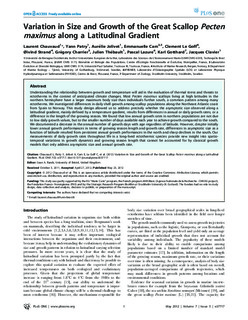| dc.contributor.author | Chauvaud, Laurent | |
| dc.contributor.author | Patry, Yann | |
| dc.contributor.author | Jolivet, Aurelie | |
| dc.contributor.author | Cam, Emmanuelle | |
| dc.contributor.author | Le Goff, Clement | |
| dc.contributor.author | Strand, Øivind | |
| dc.contributor.author | Charrier, Gregory | |
| dc.contributor.author | Thebault, Julien | |
| dc.contributor.author | Lazure, Pascal | |
| dc.contributor.author | Gotthard, Karl | |
| dc.contributor.author | Clavier, Jacques | |
| dc.date.accessioned | 2012-12-03T12:15:45Z | |
| dc.date.available | 2012-12-03T12:15:45Z | |
| dc.date.issued | 2012-05-23 | |
| dc.identifier.issn | 1932-6203 | |
| dc.identifier.uri | http://hdl.handle.net/11250/109265 | |
| dc.description.abstract | Understanding the relationship between growth and temperature will aid in the evaluation of thermal stress and threats to
ectotherms in the context of anticipated climate changes. Most Pecten maximus scallops living at high latitudes in the
northern hemisphere have a larger maximum body size than individuals further south, a common pattern among many
ectotherms. We investigated differences in daily shell growth among scallop populations along the Northeast Atlantic coast
from Spain to Norway. This study design allowed us to address precisely whether the asymptotic size observed along a
latitudinal gradient, mainly defined by a temperature gradient, results from differences in annual or daily growth rates, or a
difference in the length of the growing season. We found that low annual growth rates in northern populations are not due
to low daily growth values, but to the smaller number of days available each year to achieve growth compared to the south.
We documented a decrease in the annual number of growth days with age regardless of latitude. However, despite initially
lower annual growth performances in terms of growing season length and growth rate, differences in asymptotic size as a
function of latitude resulted from persistent annual growth performances in the north and sharp declines in the south. Our
measurements of daily growth rates throughout life in a long-lived ectothermic species provide new insight into spatiotemporal
variations in growth dynamics and growing season length that cannot be accounted for by classical growth
models that only address asymptotic size and annual growth rate. | no_NO |
| dc.language.iso | eng | no_NO |
| dc.publisher | PLoS ONE | no_NO |
| dc.subject | scallops | no_NO |
| dc.subject | kamskjell | no_NO |
| dc.subject | growth | no_NO |
| dc.subject | vekst | no_NO |
| dc.title | Variation in Size and Growth of the Great Scallop Pecten maximus along a Latitudinal Gradient | no_NO |
| dc.type | Journal article | no_NO |
| dc.type | Peer reviewed | no_NO |
| dc.subject.nsi | VDP::Agriculture and fishery disciplines: 900::Fisheries science: 920::Resource biology: 921 | no_NO |
| dc.subject.nsi | VDP::Mathematics and natural science: 400::Geosciences: 450::Oceanography: 452 | no_NO |
| dc.subject.nsi | VDP::Social science: 200::Library and information science: 320::Knowledge retrieval and organization: 323 | no_NO |
| dc.source.pagenumber | e37717 | no_NO |
| dc.source.volume | 7 | no_NO |
| dc.source.journal | PLoS ONE | no_NO |
| dc.source.issue | 5 | no_NO |
| dc.identifier.doi | http://dx.doi.org/10.1371/journal.pone.0037717 | |
